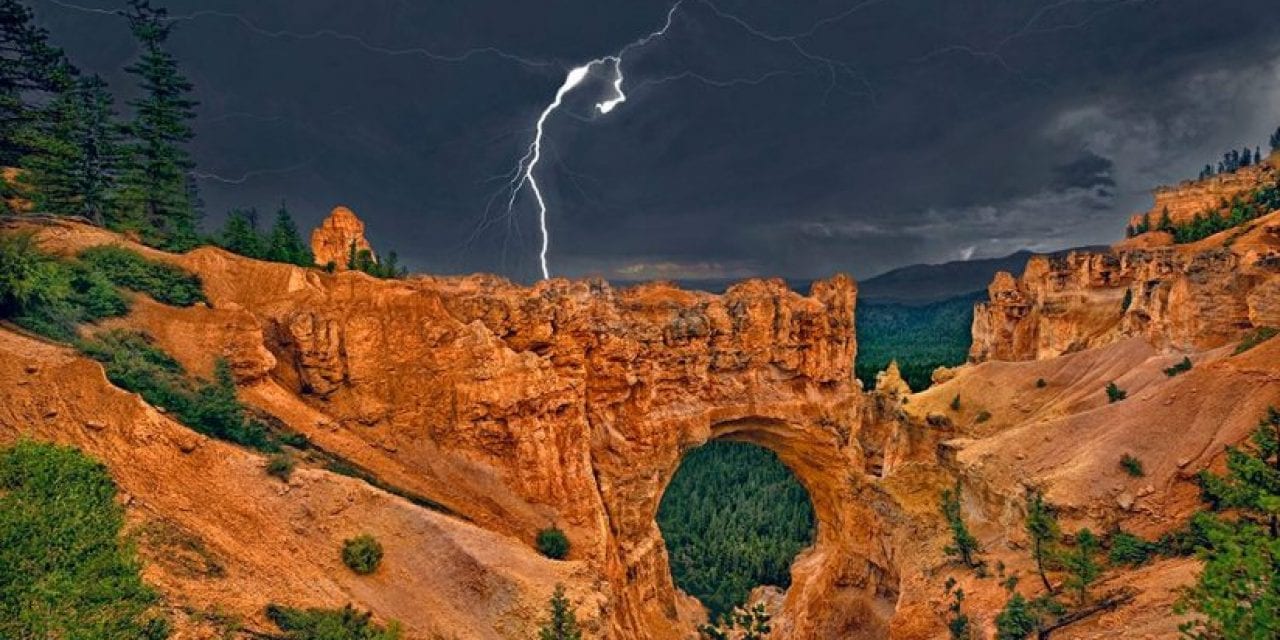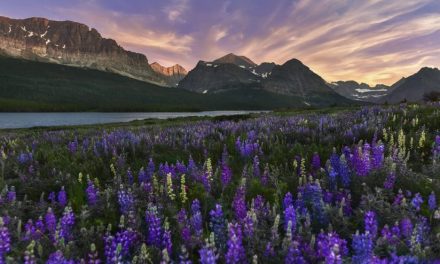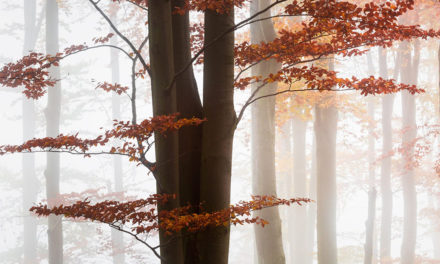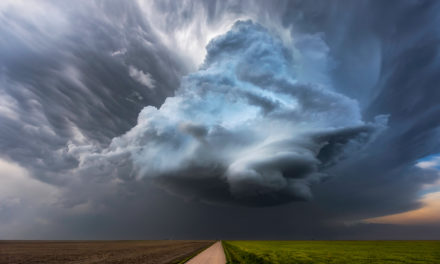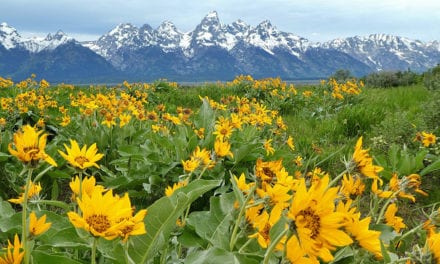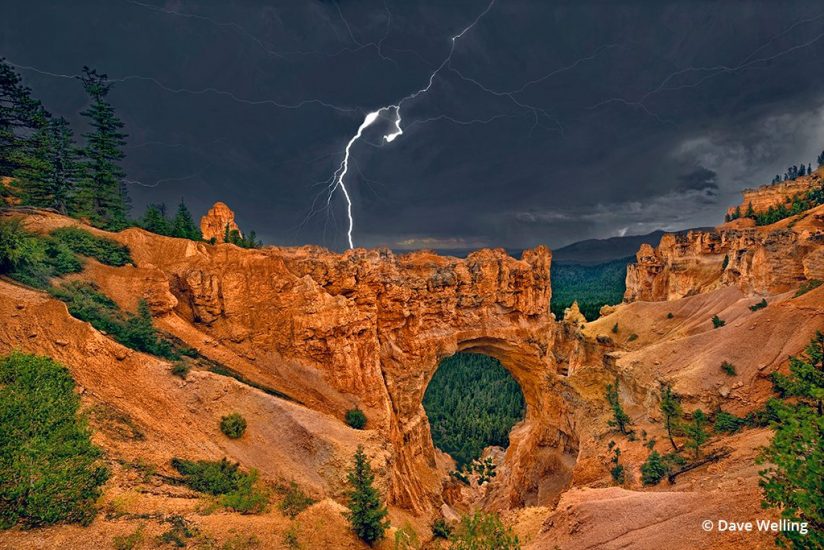
Lightning over Natural Bridge formation in Bryce Canyon National Park, Utah.
The sky darkened and the lightning flashed. I set my camera on my tripod for a stable platform, attached a lightning trigger to my flash connection, engaged mirror lockup to eliminate delay and waited. The storm cell moved toward me, the air took on a greenish tinge, the sky lit up and a tremendous thunderclap exploded. My reward was a dramatic monsoon photo of lightning striking Natural Bridge in Bryce Canyon.
With the air still glowing green, and me being the tallest point in the parking lot and standing next to a metal tripod, I decided to make a fast exit to my Jeep. Welcome to summer monsoon storm photography. It’s challenging and can be dangerous if you don’t respect the elements. It requires some special equipment to capture the best images, along with patience and luck.
The Challenges Of Monsoon Photography
The first challenge is determining when to visit to optimize your potential for storms. For monsoon photography in the American Southwest, where these images were taken, checking weather reports and contacting the staff at Grand Canyon, Bryce Canyon and Arches National Parks is recommended.
Using these resources, I made trips over five summers to Bryce and Grand Canyon before I got my monsoon. But when it finally happened, it was amazing. I have never seen skies like that. The pre- and post-storm light was perfect; the skies and clouds were dramatic, ominous and powerful. The post-storm rainbows were spectacular.
I captured magnificent mammatus clouds above the Bryce formations and the Aquarius Plateau that greeted me on my fifth summer visit. A wide-angle lens, secure tripod mounting and a cable release kept the vibrations from the wind and the mirror slap to a minimum to maximize sharpness of the hoodoos. The sky was very dark, and the hoodoos were lit by the setting sun, so a graduated neutral density filter helped me even out exposure. You could achieve similar results using two exposures, one for the clouds and one for the hoodoos, and combine them in post-processing. I just like the “old-fashioned” way.
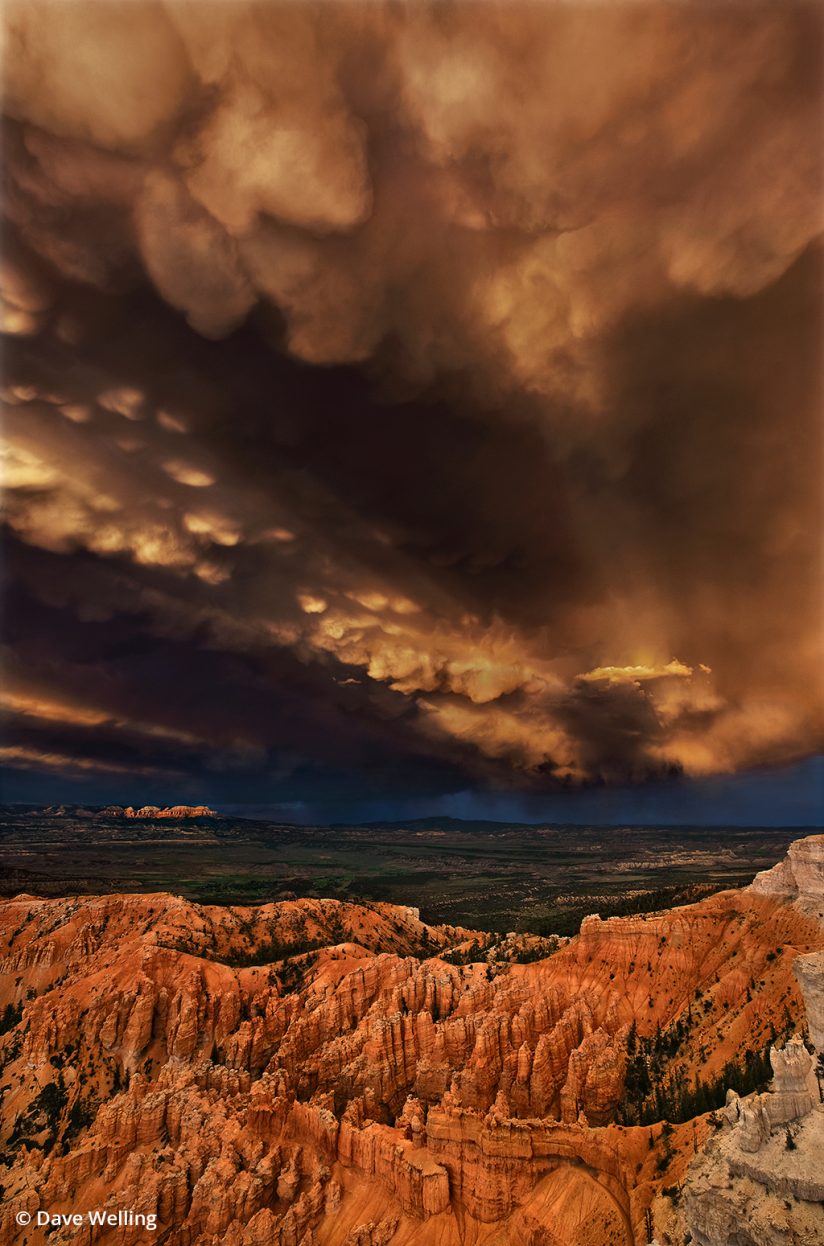
Mammatus clouds and thunderstorm over Bryce Canyon National Park, Utah.
This brings up the next challenge. Violent storms wreak havoc on your vehicle and your gear, so proper preparation is mandatory. You can utilize shuttle buses to reach the overlooks, but I use my Jeep. It gives me the most options and allows me to carry all my equipment. Make sure your vehicle can handle slick-rock dirt roads and check for flood conditions before driving to the more remote areas, like Devil’s Garden in Escalante Grand Staircase, Fantasy Canyon in eastern Utah and even the North Rim Grand Canyon roads. Check with park service or BLM personnel for current road conditions and weather reports for potential torrential rain. Keep emergency supplies in your vehicle.
When photographing in the elements, watch for lightning. Don’t tempt fate for that ultimate photo. I left Natural Bridge fast when the lightning got close. I may have missed a photo, but I lived to talk about the ones I got. Wear waterproof raingear and hiking boots, and layer your clothes—these areas can get cold. Protect your camera and lenses with rain covers, and keep a cloth handy that will not damage lens elements to wipe off your gear. Tripods are usually necessary for lower-light conditions, but keep a tight hold on yours so it doesn’t blow over in the wind. I forgot one day, and several thousand dollars’ worth of equipment crashed to the ground. I lost both the gear and the ability to photograph.
A technical challenge is photographing the lightning itself. You can’t press the shutter fast enough to capture lightning strikes. Leave the shutter open, and you get fuzzy lightning. The solution is to use a lightning trigger attached to your flash connector. Put your camera on a tripod with settings on manual, turn off auto-focus, lock up the mirror and the device triggers the shutter when lightning strikes, even at great distances. I use The Lightning Trigger from Stepping Stone Productions. You can test the device by triggering it with your flash unit before using.
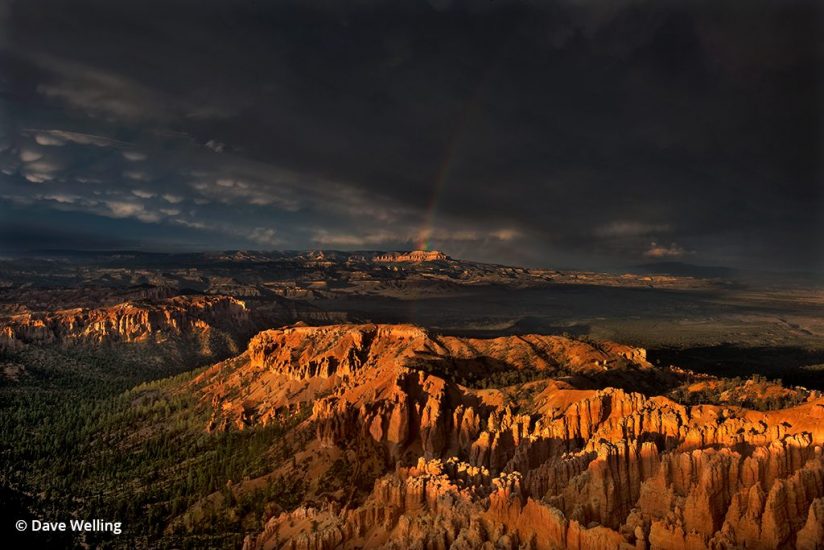
Rainbow over the Aquarius Plateau after a monsoon thunderstorm, Bryce Canyon National Park, Utah.
The monsoons lasted several days, giving me the opportunity to photograph the violent weather and post-storm, soft light from several overlooks along the main road providing different perspectives of the hoodoos and storms. Most overlooks face east. If the storms break up to the west, you can photograph late-afternoon, golden light on the hoodoos with dramatic skies to the east. Storm edges also produce magnificent rainbows, adding to your overall image. In one of my favorite monsoon images, a rainbow appears to rise out of the Aquarius Plateau formation far to the east, adding another element to this dramatic landscape.
Recommended Places For Monsoon Photos
Grand Canyon is another great location for monsoon photography. I prefer the North Rim. It’s less crowded, and the storm photography is great. This is high desert country, so layer accordingly. Facilities at the North Rim include a lodge, campground, restaurant, snack shop, market and gas station. Monsoon storms kick up in the afternoon, and photography right from the lodge can be spectacular. Summer reservations for the campground or lodge are mandatory.
The road to the North Rim heads south from Jacob Lake. A very convenient way to create a great two-stop monsoon landscape photography trip is to head south on Highway 89 from Bryce Canyon through Mt. Carmel Junction and Kanab to Fredonia, Arizona. In Fredonia, take Highway 89A southeast to Jacob Lake and the road south to the North Rim.
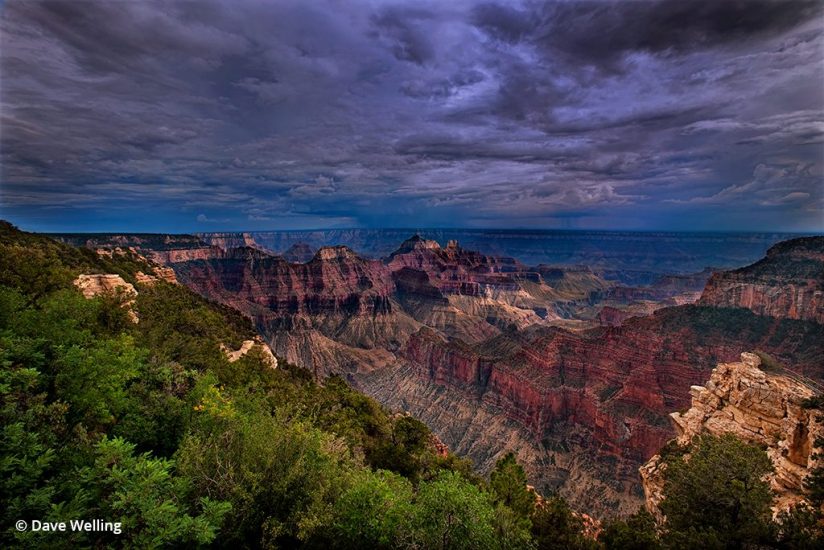
Monsoon storm forms over the North Rim of Grand Canyon National Park, Arizona.
There are two great monsoon photography overlooks on the North Rim, Point Imperial and Cape Royal. Both are some distance from the lodge, so driving is necessary. The road from the lodge splits, going to both overlooks, which are in opposite directions.
Point Imperial overlooks the far east edge of the Canyon. To the east is low and flat, so sunrise can be spectacular, especially if storm clouds are present. I have seldom seen clouds light up like they can here after a storm. It’s approximately 11 miles to Point Imperial from the lodge, so allow yourself plenty of time to arrive before sunrise and find your composition. Elevations are over 8,200 feet, so it can get cold, and roads, although paved, can be icy. There are numerous pullouts along the way, so watch for additional landscape opportunities.
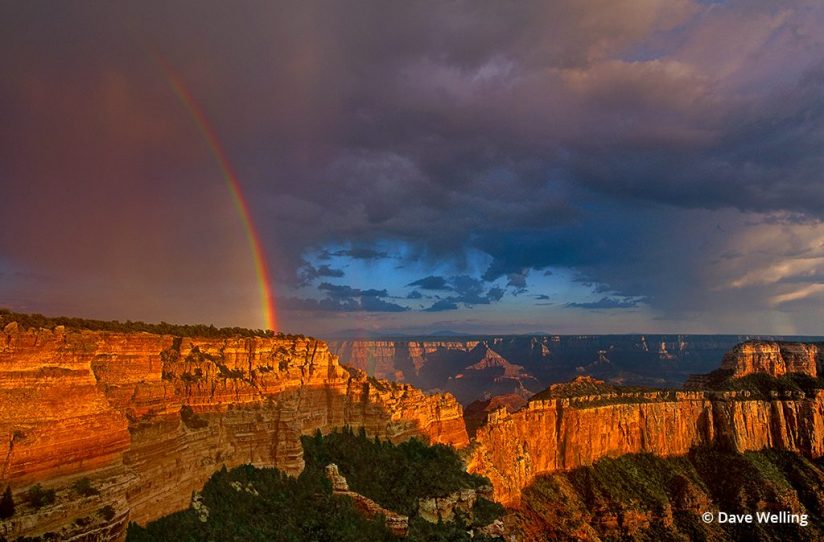
A rainbow over Cape Royal on the North Rim of Grand Canyon National Park, Arizona.
Cape Royal is in the opposite direction from the road split and is about 23 miles from the lodge. With a 270-degree angle of view, this overlook is great for photography most of the day. If there is a storm, late-afternoon light turns the sheer cliff face of Wotan’s Throne golden red. As a storm dissipated, I captured this beautiful light just as a rainbow formed over the cliffs. Plan on three to four days in each location to successfully capture the storms.
If you have extra time and the monsoons are cooperating, there are additional, although out-of-the-way, locations that offer opportunities for seldom-photographed landscapes. Devil’s Garden, south of Escalante, Utah, is a small but interesting area noted for the rock formations called the “Trolls.” They can be great subjects framed in dark, ominous skies and lightning strikes. The road is slick-rock dirt, so check with the BLM office in Escalante for road conditions before driving.
Fantasy Canyon, in the middle of a working oilfield near Vernal, Utah, is fascinating, and storms can make it magic. The formations in this 1-acre plot are off white during the day but turn golden yellow in late afternoon. I found a great formation and waited for late-afternoon light. A rainbow formed over the sandstone adding a key element to the overall scene. This image was a result of patience and luck. Remember, luck favors the prepared!
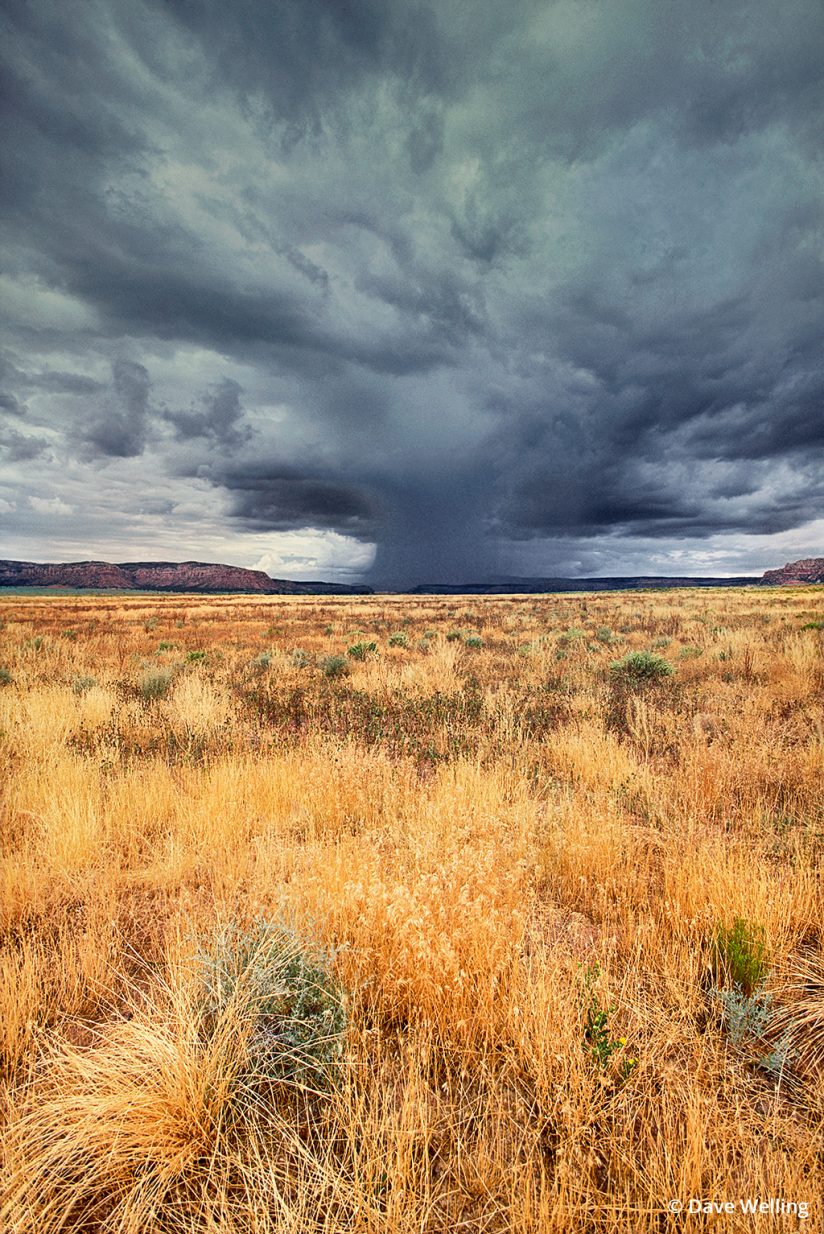
Monsoon storm cell over the high desert near Kanab, Utah.
For an expanded trip, consider other locations, like Capitol Reef, Cedar Breaks and Arches National Parks, as well as Goblin Valley.
Don’t forget to keep a camera setup by your side as you drive. You never know what you might see along the roads. A distant, violent storm cell appeared just after a curve in the road. I was on my way to the North Rim. Stopping along the road for just a few minutes, I framed desert grasses as a foreground element and captured a powerful, high desert landscape.
Opportunities for monsoon photography abound in the Southwest, but there are chances for summer storm photography in many areas of the country. Check the weather, pack your camera rain gear and head out this summer to see what dramatic images you will create.
See more of Dave Welling’s work at strikingnatureimagesbydavewelling.com.
The post Monsoon Photography In The Southwest appeared first on Outdoor Photographer.

